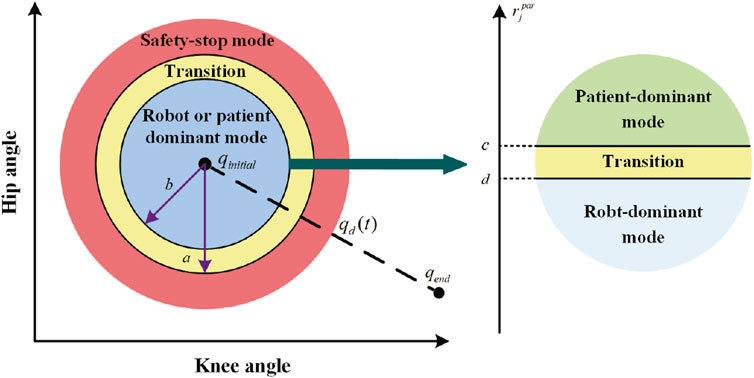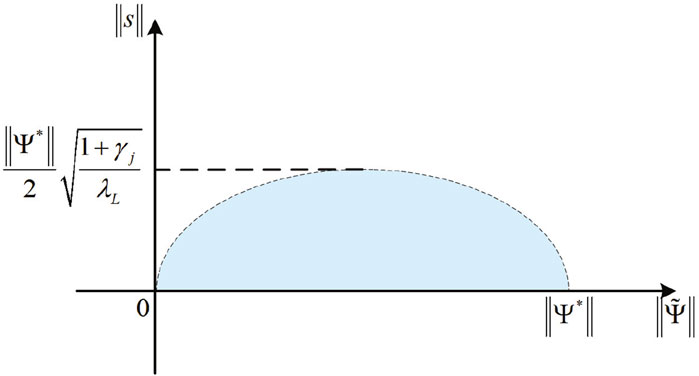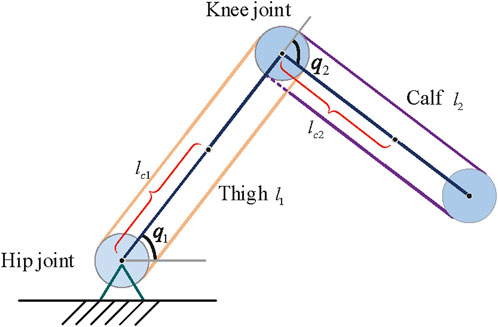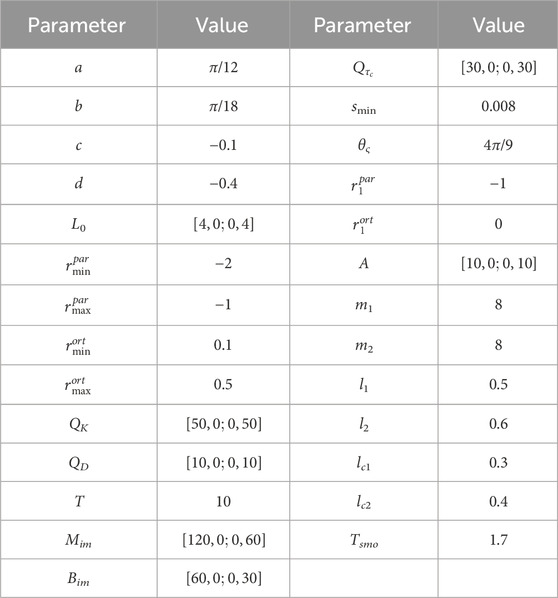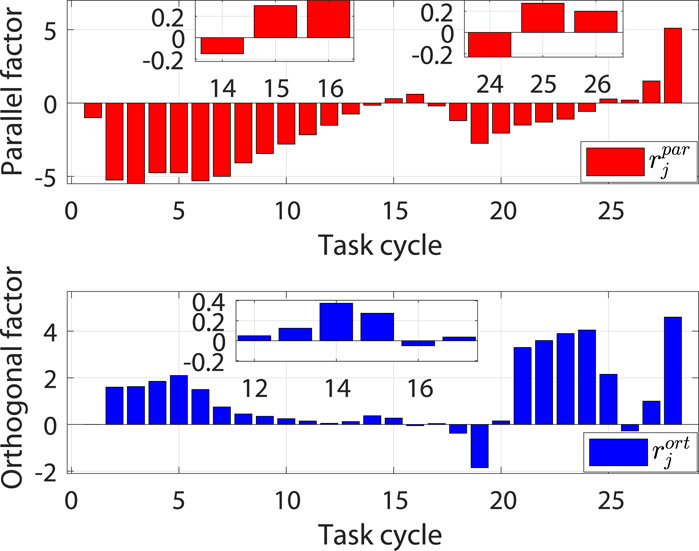- 1School of Automation and Intelligence, Beijing Jiaotong University, Beijing, China
- 2Department of Mechanical and Electrical Engineering, North China University of Technology, Beijing, China
- 3School of Power and Mechanical Engineering, Wuhan University, Wuhan, China
- 4Faculty of Medicine, The Chinese University of Hong Kong, Shatin, China
- 5Institute of Automation, Chinese Academy of Sciences, Beijing, China
- 6Faculty of Information Technology, Beijing University of Technology, Beijing, China
Different patients have different rehabilitation requirements. It is essential to ensure the safety and comfort of patients at different recovery stages during rehabilitation training. This study proposes a multi-mode adaptive control method to achieve a safe and compliant rehabilitation training strategy. First, patients’ motion intention and motor ability are evaluated based on the average human–robot interaction force per task cycle. Second, three kinds of rehabilitation training modes—robot-dominant, patient-dominant, and safety-stop—are established, and the adaptive controller can dexterously switch between the three training modes. In the robot-dominant mode, based on the motion errors, the patient’s motor ability, and motion intention, the controller can adaptively adjust its assistance level and impedance parameters to help patients complete rehabilitation tasks and encourage them to actively participate. In the patient-dominant mode, the controller only adjusts the training speed. When the trajectory error is too large, the controller switches to the safety-stop mode to ensure patient safety. The stabilities of the adaptive controller under three training modes are then proven using Lyapunov theory. Finally, the effectiveness of the multi-mode adaptive controller is verified by simulation results.
1 Introduction
In recent years, the number of patients with movement disorders caused by stroke and spinal cord injury has increased rapidly, as has the corresponding rehabilitation demand. Traditional rehabilitation strategies rely on therapists to help patients participate in training, and there are some problems such as long rehabilitation cycle and low efficiency of rehabilitation which make it difficult to meet the growing recovery needs (Luo et al., 2019). As a new way of rehabilitation training, rehabilitation robots can effectively save medical resources and improve the efficiency of rehabilitation training. Therefore, this has received wide attention and recognition (Adhikari et al., 2023).
The control method plays a crucial role in the rehabilitation effect (Zhou et al., 2021) as the patient has been interacting with the robot during the training process. Traditional control methods may subject the patient to excessive torque, which increases the risk of secondary injury. In contrast, control methods based on human–robot interactive information can have good rehabilitation training effects (Guo et al., 2021). Such methods can not only effectively avoid potential injuries but also help improve recovery. Therefore, it is important to design a safe, natural, and compliant human–robot interaction control method for rehabilitation robot systems (Masengo et al., 2023; Bergmann et al., 2023; Li Z. et al., 2024; Lu et al., 2023).
For patients with weak motor ability, rehabilitation robots should provide enough assistive force to help complete training tasks. However, too much assistance may make patients slack off, and too little assistance will not help patients implement training tasks—both may reduce rehabilitation effects. In order to realize efficient rehabilitation training, human–robot interaction methods need to follow the assisted-as-need (AAN) principle (Li N. et al., 2024). At present, impedance control is usually used to implement the AAN strategy (Han et al., 2023). Mao et al. (2015) established a force field controller which constructs a virtual tunnel with impedance characteristics around the desired trajectory to assist the patient’s movement. Jamwal et al. (2016) built an impedance controller for an ankle robot to assist patient compliance. Due to individual differences, it is difficult to obtain optimal impedance parameters. In addition, the interaction force and motion speed change over time, and fixed impedance parameters usually cannot meet the practical needs. The dynamic relationship between motion and interaction force can be adjusted according to the actual task by using time-varying impedance control; thus, good dynamic interaction performance can be achieved (Liang et al., 2022). Asl et al. (2020) constructed an AAN impedance controller which utilizes velocity tracking errors to adjust impedance parameters online. However, only the damping parameter is adjusted in this study, and its adaptive adjustment ability is relatively limited. Han et al. (2023) proposed an AAN control strategy for rehabilitation robots based on patients’ motor intention and task performance. The learning efficiency of impedance parameters and the auxiliary level were adaptively adjusted according to the assessment results of interaction force and patient performance. The experimental results show that this method can motivate patients to increase their engagement.
For patients with a partial recovery of motor function or strong motor ability, interference with their movement should be reduced to provide sufficient freedom of movement (Han et al., 2023; Zhang and Cheah, 2015). Higher freedom of movement does not mean that patients can move without restriction. When the position and speed of robots reach a certain level, patients may be exposed to the potential risk of secondary injury (Gao et al., 2023). To ensure patient safety, control methods should have safety features such as emergency stops or motion position limitations.
To meet the needs of patients at different recovery stages and ensure their safety, multi-mode control strategies have been proposed (Zhang and Cheah, 2015; Li et al., 2021; Yang et al., 2023; Xu et al., 2019; Li et al., 2017a,b). Zhang and Cheah (2015) proposed a multi-mode control method for upper limb rehabilitation robots. The training mode is chosen based on the position error to realize safety assistance. Li et al. (2021) and Yang et al. (2023) also designed multi-mode control strategies and switched control modes according to the tracking error. These methods switch control modes according to the position errors, which will partly limit the movement freedom of patients with strong motor ability. To solve this problem, a patient’s bioelectrical or interactive force signals can be used as the basis for switching training modes. Xu et al. (2019) proposed a multi-mode adaptive control strategy for a sitting lower limb rehabilitation robot. The human–robot interaction torque is estimated by using an EMG-driven impedance model. Based on the estimated human–robot interaction torque, a smooth transition between the robot-dominant and human-dominant modes can be achieved. Compared with bioelectrical signals, interaction force signals are more reliable. Li et al. (2017a) proposed an adaptive control method to smoothly switch the training modes between robot- and human-dominant modes based on the human–robot interaction force to realize safe interaction between humans and robots. Since this method ignores trajectory errors, the trajectory errors in the human-dominant mode may be large, which will lead to a reduction in the training effect. In the multi-mode control strategy, relying on only a single signal cannot provide the most suitable rehabilitation training mode for patients. Li et al. (2017b) proposed a multi-mode control strategy in which the tracking error and human-robot interaction force are taken as the basis for mode switching. Based on the tracking error, the controller can switch flexibly between human- and robot-dominant modes. When the human–robot interaction force exceeds the safety threshold, the controller will switch to the safety-stop mode to ensure the patient’s safety. This method still uses the tracking error as the basis for switching between human- and robot-dominated modes, which will also limit the movement freedom of patients with strong motor ability. In addition, the interaction force signals cannot fully indicate the patients’ motor ability.
To solve such problems, a multi-mode adaptive control strategy for repetitive rehabilitation tasks is here proposed. The human–robot interaction force evaluation factor is introduced to assess a patient’s motor ability and motor intention online (Han et al., 2023). Based on the evaluation result of the patient’s motor ability and trajectory errors, the training mode can be freely switched between robot-dominant, patient-dominant, and safety-stop modes. In the robot-dominant mode, the robot’s assistance level and the learning efficiency of impedance parameters are periodically adjusted according to the trajectory error, speed error, the assessed motor ability, and the motion intention, so as to provide appropriate assistance for patients with different motor abilities. In the patient-dominant mode, the controller allows the patient to modify the reference speed so that patients with higher motor ability have enough freedom of movement. When the trajectory error exceeds the safe range, it switches to safety-stop mode to ensure patient safety. The proposed method is not only suitable for patients at different stages of recovery and with different motor abilities but can also stimulate their enthusiasm to participate in rehabilitation training, further enhancing the rehabilitation effect.
2 Dynamic model of the human–robot hybrid system
During the rehabilitation training, the lower limb rehabilitation robot is in close contact with the patients’ affected limb, forming a human–robot hybrid system. The hybrid system’s dynamic model is shown as Eq. 1.
where
where J(q) represents the Jacobian matrix.
3 Multi-mode control method
The functions and designs of the three control modes are briefly introduced in this section. For repetitive tasks, when the patient does not have enough motor ability to independently complete the training task, the robot-dominant mode runs. Adaptive assistance is then provided according to the patient’s motor ability and motion intention. For patients with weak motor ability, the assistance level will be periodically increased. For patients with a certain motor ability but who cannot yet complete the task independently, the assistance intensity will reduce appropriately to encourage more active participation in the training task. When the patient has recovered part of the motor function and can complete the training task independently, the patient-dominant mode runs. In this case, only movement speed is adjusted to provide the patient with a high degree of freedom of movement. When the patient’s movement is abnormal or the task is too difficult, the robot’s trajectory may exceed the safe range. In this case, the safety-stop mode runs to ensure patient safety.
3.1 Design of human–robot interaction force evaluation factor and mode shift factor
According to the functional requirements of the three control modes, a unified control law is established that includes the reference term, impedance learning term, sliding term, and compensation term, as shown below.
where M, C, and G are abbreviations of
where
When
The change pattern of α and β is designed as follows:
where a and c are given values.
The control diagram is shown in Figure 1. To ensure patient safety, the safety-stop mode has the highest priority among the three modes, which is reasonable in practical applications. To ensure the smoothness of the mode switching process, transition intervals are added to Eqs 6, 7, and then the change pattern of α and β is modified as Eqs 8, 9.
where b and d are given values. The modified α and β change smoothly as
where αs = α(t1 − ts), ts is the sampling time, and Tsmo is the smoothing time. Thus, α is smooth in time.
Although Eq. 10 can ensure the continuity of α, Tsmo may also cause a lag in mode switching. Therefore, the value of Tsmo should not be too large in practical applications.
3.2 The Robot-dominant mode
When α = 1, β = 0, the controller is in the robot-dominant mode. In this mode, the human–robot interaction torque is described as Eq. 11 (Han et al., 2023; Yang et al., 2011):
where the stiffness parameters
In this mode, Eq. 3 can be written as Eq. 13.
where the update rules of K(t), D(t), L(t), and
The update law for L(t) is designed as follows:
where
where η0 = 0. L0 is a positive definite matrix. In this mode,
The update law for K(t), D(t), and
where γj is updated as shown in Eq. 17.
where
In this mode, based on the assessment of motor ability and motor intention,
3.3 The patient-dominant mode
When α = 0, β = 0, the controller is in the patient-dominant mode. In this mode, Eq. 3 can be written as Eq. 18.
where
where Llast denotes the last updated value of L(t) before entering this mode.
where Mim and Bim denote the inertia and damping parameters, respectively.
To ensure the stability of human–robot interactions and encourage active patient participation, τc was utilized to appropriately compensate τh (Zhang and Cheah, 2015). When the absolute value of the angle θh,s between τh and s is smaller than θς and
where
and
where smin is a small positive number.
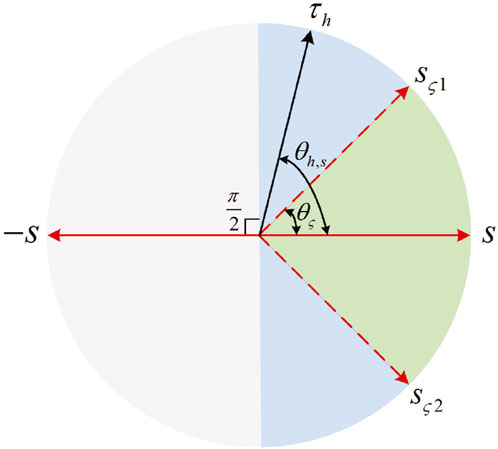
Figure 3. Schematic diagram of the compensation principle. When
In this mode, the impedance learning term is removed, and the sliding mode control term is converted to a speed control term. In addition, the patient can modify the reference speed, improving compliance with and the flexibility of rehabilitation training. τc is used to compensate τh appropriately. Compared with the robot-dominant mode, the patient-dominant mode further improves the patient’s freedom of movement.
3.4 The safety-stop mode
When α = 0, β = 1, the controller is in the safety-stop mode. In this mode, Eq. 3 can be written as Eq. 24.
where
τc is utilized to neutralize τh—that is, τc + τh = 0. From the definition of
In this mode, the impedance learning term is removed, and the sliding mode control term is converted to a damping control term. The robot stops moving to ensure the patient’s safety.
4 Stability analysis
In this section, the Lyapunov stability theorem is used to establish the stability of the human–robot interaction process. Specifically, in the robot-dominant mode, s is limited to a certain bound. Under the assumption of Eq. (12), the learning errors of impedance parameters and torque compensation terms are bounded (Han et al., 2023). In the patient-dominant mode, the robot’s speed converges to
The Lyapunov candidate function is chosen as Eq. 26.
where
where
4.1 Stability analysis in the robot-dominant mode
In this mode, the system is stable if
Taking the derivative of
Since
Combining Eq. 31 and the definition of s, we then have
Since α = 1, β = 0, Eq. 33 can be expressed as Eq. 34.
Then, we can get Eq. 35
Since L(t) is periodically adjusted, the following inequality can be obtained:
where λL is the smallest eigenvalue of L(σ).
According to Eqs 12, 28, 36, we thus obtain Eq. 37
that is,
According to Eqs 27–29, we obtain
Since
Since
Similarly, Item b and Item c in Eq. 39 can be expressed as follows:
and
By bringing Eqs 41–43 into Eq. 39, we obtain
By bringing Eqs 38, 44 into Eq. 30, we obtain Eq. 45.
Since
A sufficient condition for ΔV to be non-positive definite is
When Item d in Eq. 47 is equal to zero, we obtain
According to LaSalle’s theorem,
Since
From the inequality (Eq. 47),
4.2 Stability analysis in the patient-dominant mode
In this mode, α = 0, β = 0.
and
By the definition of
To determine the consistent continuity of
where
The boundedness of s suggests the boundedness of
4.3 Stability analysis in the safety-stop mode
When the trajectory error is too large, it will switch to the patient-dominant mode—α = 0, β = 1.
where
5 Simulations
A two-degree-of-freedom lower limb rehabilitation robot is used to verify the effectiveness of the proposed method. As shown in Figure 5, m1 and m2 represent the mass of the thigh and calf, respectively. l1 and l2 represent the length of the thigh and calf, respectively. lc1 denotes the distance from the hip joint to the center of mass of the thigh. lc2 denotes the distance from knee joint to the center of mass of the calf. The dynamic model of this hybrid system is described as Eq. 55
where
The initial angle of the robot is set to
The simulation process consists of 28 task cycles, each lasting 10 s. The results of the human–robot interaction force evaluation for each task cycle are given in Figure 6, which shows the patients’ motor ability and motion intention under different task cycles. The simulation results are shown in Figure 7.
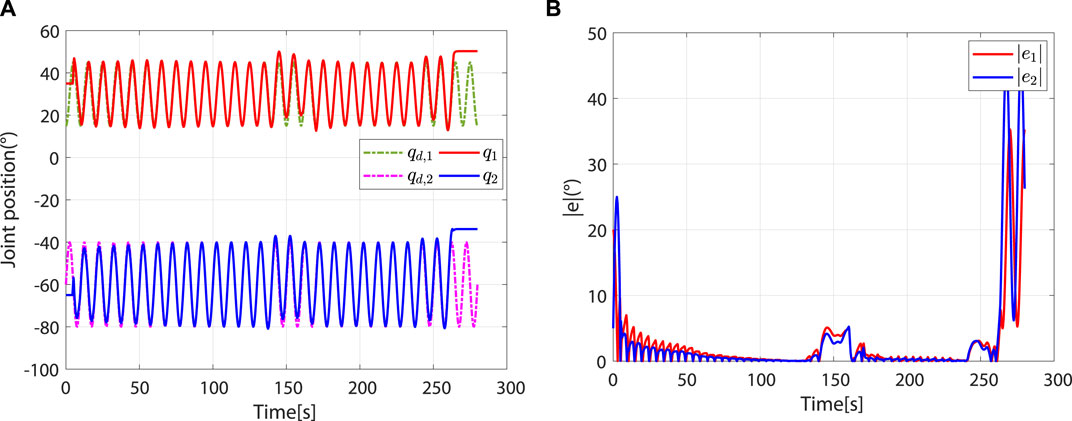
Figure 7. Entire simulation results of hip and knee joints. (A) Desired and actual trajectories. (B) Absolute values of trajectory errors.
At the beginning, the controller is in safety-stop mode due to
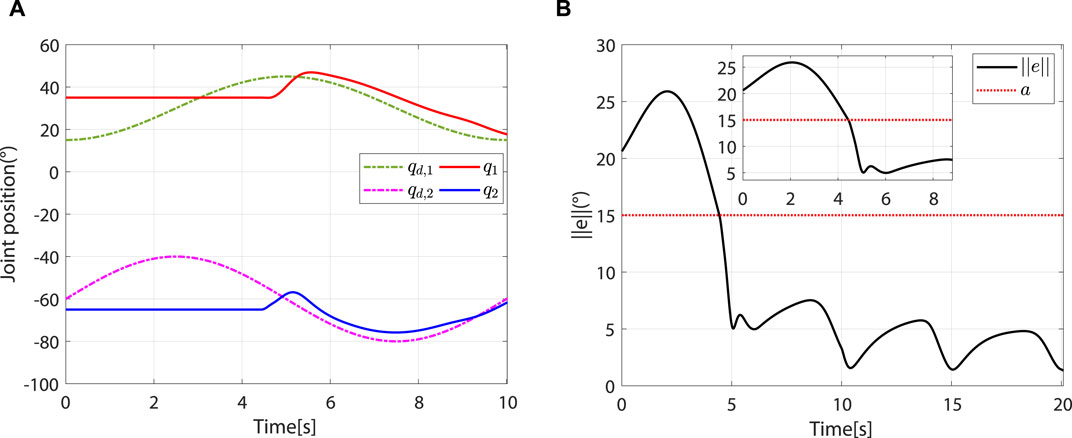
Figure 8. The controller leaves the safety-stop mode at approximately 4.44 s. (A) Desired and actual trajectories. (B) At approximately 4.44 s,
In the robot-dominant mode, according to
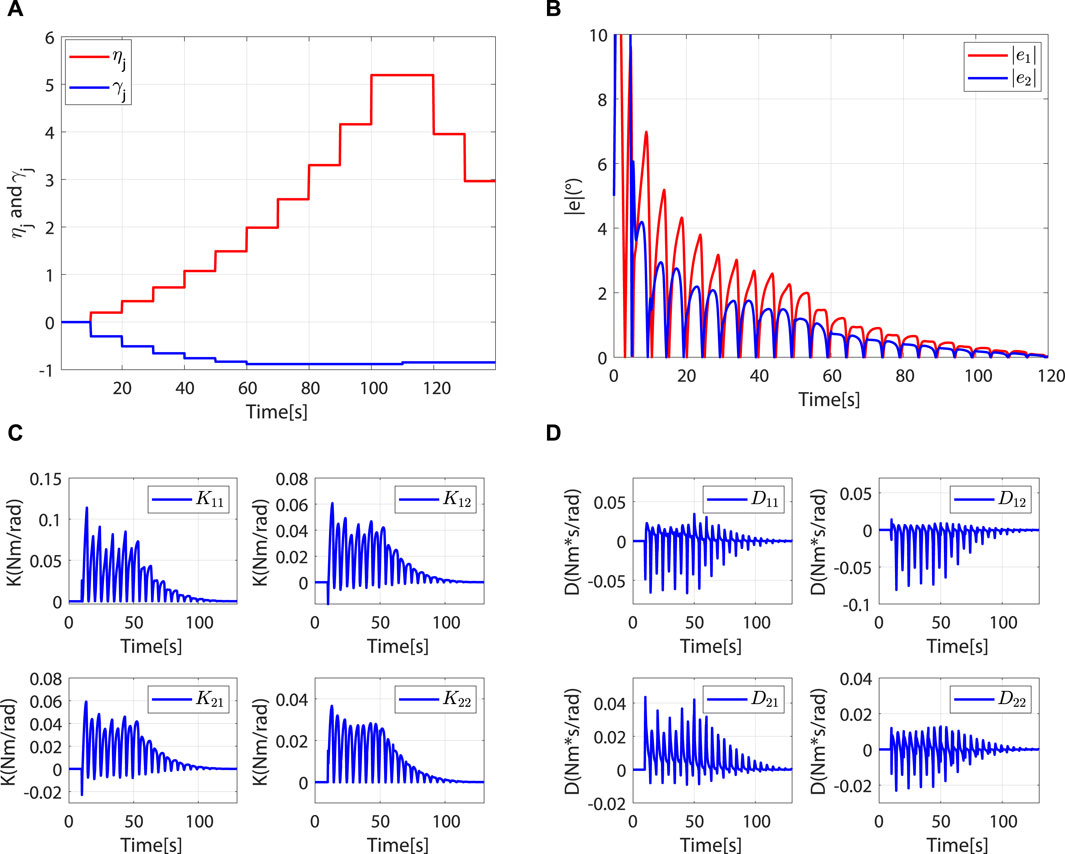
Figure 9. The controller is in the robot-dominant mode, and the robot assisted the patient to complete the rehabilitation task. (A) ηj and γj. (B) Absolute values of trajectory errors. (C) K(t). (D) D(t).
When
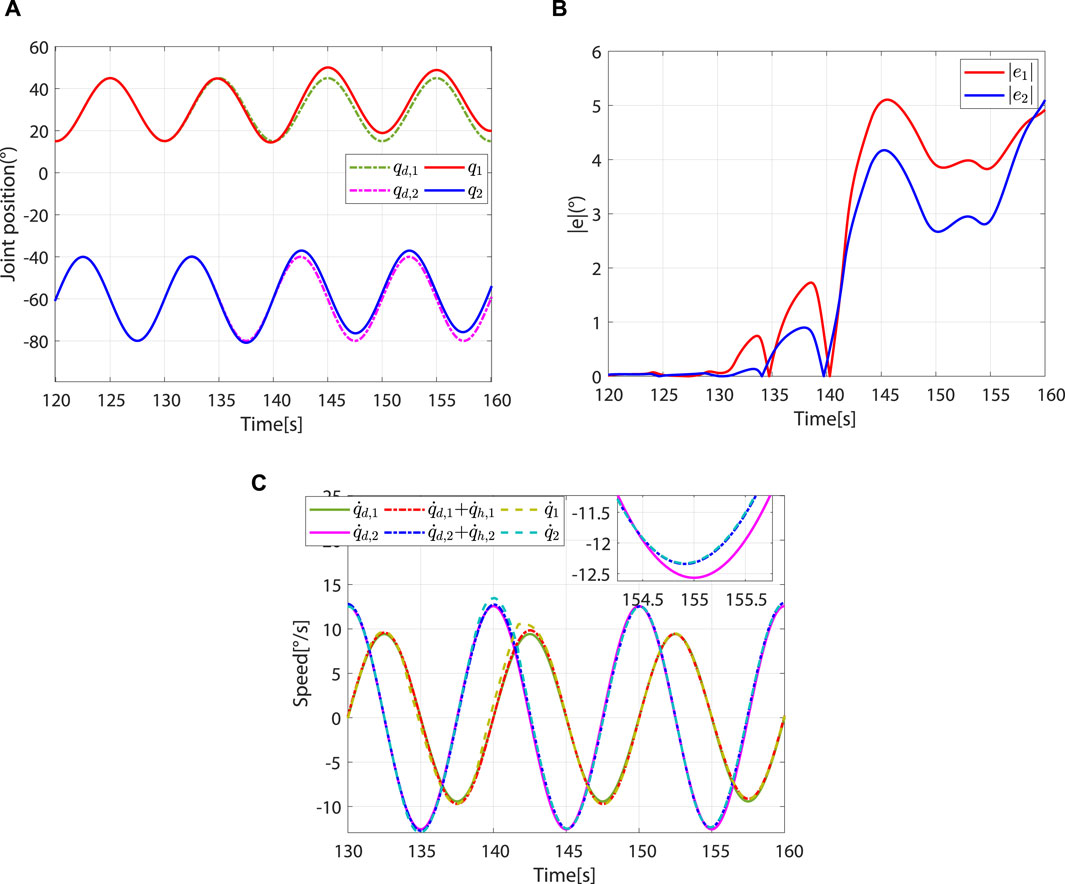
Figure 10. Controller switches from robot-dominant to patient-dominant mode and remains in the patient-dominant mode. (A) Desired and actual trajectories. (B) Absolute values of the trajectory errors. (C) Desired angular speed, reference angular speed, and actual angular speed.
As
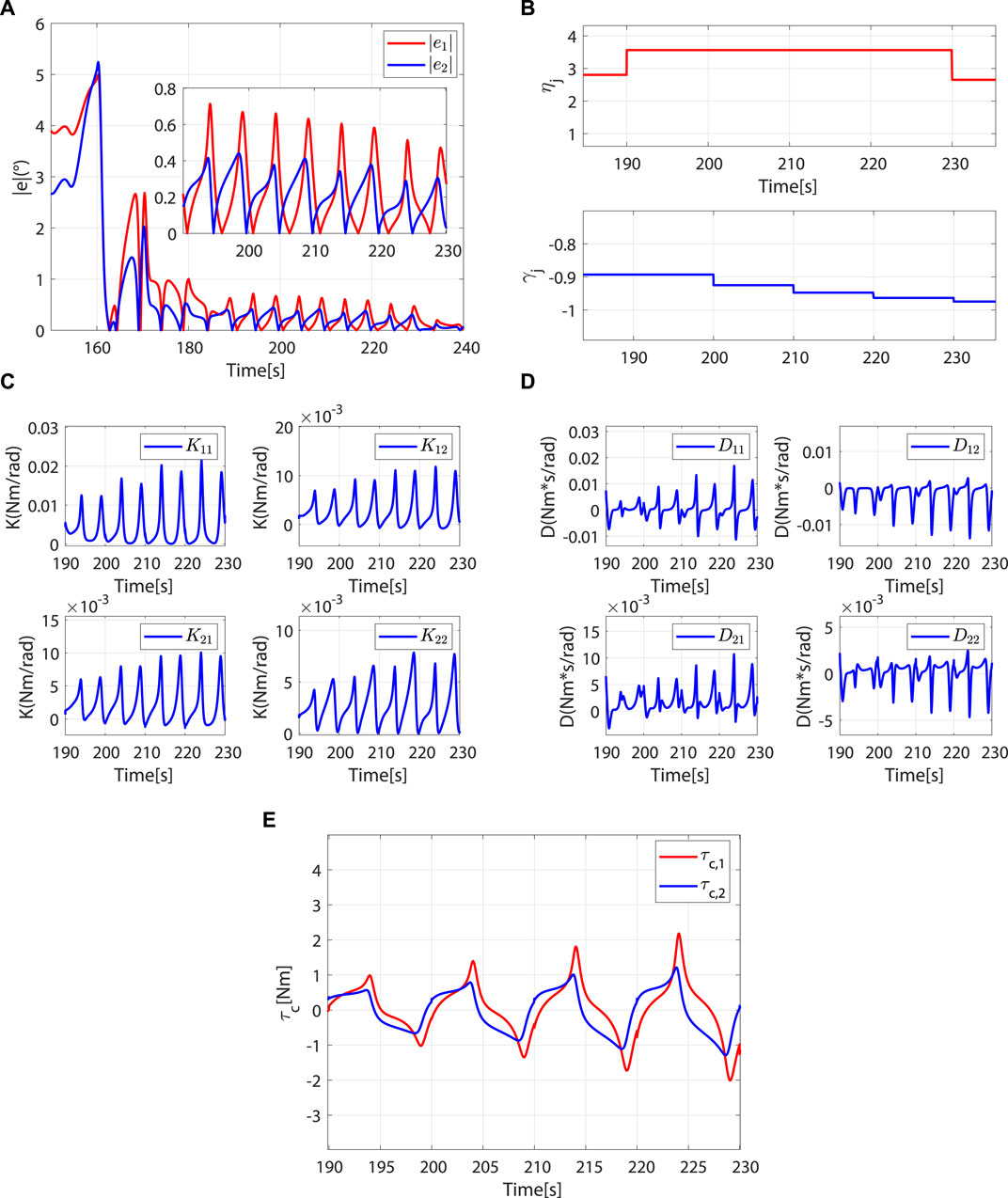
Figure 11. Controller switches from patient-dominant to robot-dominant mode and remains in the robot-dominant mode. (A) Absolute values of trajectory errors. (B) ηj and γj. (C) K(t). (D) D(t). (E) τc(t).
When
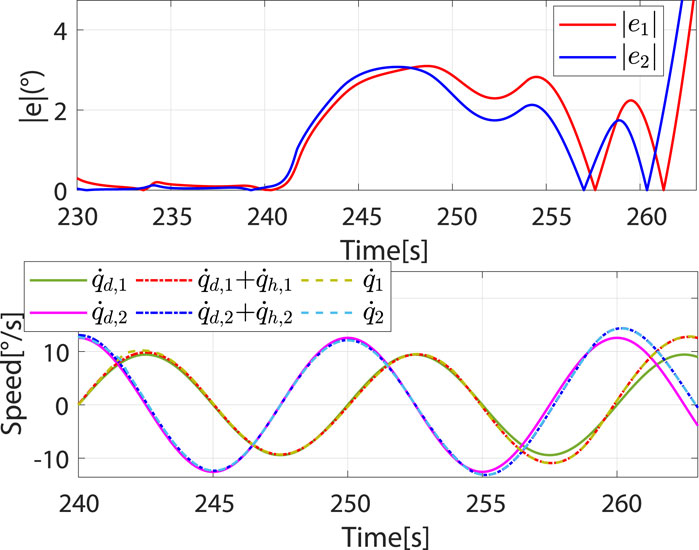
Figure 12. Speed and absolute values of trajectory errors when controller switches again from robot-dominant to patient-dominant mode.
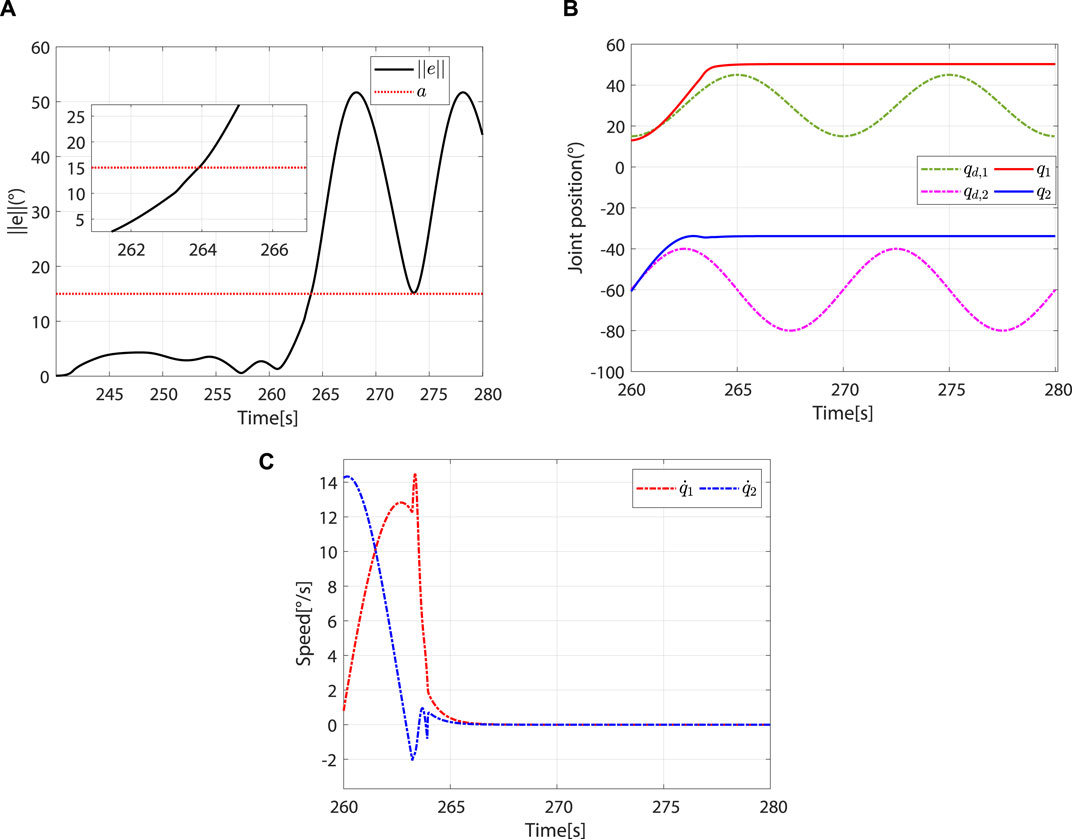
Figure 13. The controller switches to the safety-stop mode. (A) At approximately 263.92 s,
The effectiveness of the proposed method is demonstrated by the trajectory errors, adaptive change of controller parameters, and joint angular speed during human–robot interaction in three modes. In addition, the simulation includes the transition process between each mode, and the system can still run stably during this transition process.
6 Conclusion
This study proposes a multi-mode adaptive control method, including robot-dominant, patient-dominant, and safety-stop modes. The patient’s motor ability and the system’s trajectory error are taken as the basis for mode switching. Based on the patients’ motor ability, the controller can switch between robot-dominant and patient-dominant modes. Trajectory errors are used to determine whether to switch to the safety-stop mode. The proposed control strategy is not only suitable for patients with different motor abilities and rehabilitation stages but also guarantees safety during rehabilitation training. Since the transition between robot-dominant and patient-dominant modes does not depend on the trajectory errors, the patient-dominant mode allows for greater trajectory errors than the robot-dominated mode, and the reference speed can be modified by the patient, improving their freedom of movement. The stability of the proposed method under three control modes is analyzed using Lyapunov theory. Numerical simulations are carried out on a two-degree-of-freedom lower limb rehabilitation robot to verify the effectiveness of the proposed method. Our future work will focus on clinical applications.
Data availability statement
The original contributions presented in the study are included in the article/supplementary material; further inquiries can be directed to the corresponding author.
Author contributions
XL: conceptualization, formal analysis, and writing–original draft. YY: methodology, software, and writing–original draft. SD: data curation, formal analysis, and writing–review and editing. ZG: conceptualization, validation, and writing–review and editing. ZL: investigation and writing–review and editing. SL: investigation, validation, and writing–review and editing. TS: formal analysis, project administration, software, and writing–original draft.
Funding
The authors declare that financial support was received for the research, authorship, and/or publication of this article. This work was supported by the National Key R&D Program of China under Grant 2023YFE0202100; the Natural Science Foundation of China under grants 62373013, 62103007, 62203442, and 62003005; the R&D Program of Beijing Municipal Education Commission under grants KM202110009009 and KM202210009010; the Natural Science Foundation of Beijing under grants L202020 and 4204097; and the Talent Fund of Beijing Jiaotong University under grant KAIXKRC24003532.
Conflict of interest
The authors declare that the research was conducted in the absence of any commercial or financial relationships that could be construed as a potential conflict of interest.
Publisher’s note
All claims expressed in this article are solely those of the authors and do not necessarily represent those of their affiliated organizations, or those of the publisher, the editors, and the reviewers. Any product that may be evaluated in this article, or claim that may be made by its manufacturer, is not guaranteed or endorsed by the publisher.
References
Adhikari, B., Bharadwaj, V. R., Miller, B. A., Novak, V. D., and Jiang, C. (2023). Learning skill training schedules from domain experts for a multi-patient multi-robot rehabilitation gym. IEEE Trans. Neural Syst. Rehabil. Eng. 31, 4256–4265. doi:10.1109/TNSRE.2023.3326777
Asl, H. J., Yamashita, M., Narikiyo, T., and Kawanishi, M. (2020). Field-based assist-as-needed control schemes for rehabilitation robots. IEEE ASME Trans. Mechatron. 25, 2100–2111. doi:10.1109/TMECH.2020.2992090
Bergmann, L., Voss, D., Leonhardt, S., and Ngo, C. (2023). Lower-limb exoskeleton with compliant actuators: human cooperative control. IEEE Trans. Med. Robot. 5, 717–729. doi:10.1109/TMRB.2023.3290982
Gao, M., Chen, J., Li, M., and Dai, J. S. (2023). “Design and evaluation of a novel self-adaptive ankle rehabilitation exoskeleton with elastic modules,” in 2023 international conference on advanced robotics and mechatronics (ICARM), 900–905. doi:10.1109/ICARM58088.2023.10218858
Guo, L., Lu, Z., and Yao, L. (2021). Human-machine interaction sensing technology based on hand gesture recognition: a review. IEEE Trans. Hum. Mach. Syst. 51, 300–309. doi:10.1109/THMS.2021.3086003
Han, S., Wang, H., and Yu, H. (2023). Human-robot interaction evaluation-based AAN control for upper limb rehabilitation robots driven by series elastic actuators. IEEE Trans. Robot. 39, 3437–3451. doi:10.1109/TRO.2023.3286073
Jamwal, P. K., Hussain, S., Ghayesh, M. H., and Rogozina, S. V. (2016). Impedance control of an intrinsically compliant parallel ankle rehabilitation robot. IEEE Trans. Ind. Electron. 63, 3638–3647. doi:10.1109/TIE.2016.2521600
Li, N., Yang, Y., Li, G., Yang, T., Wang, Y., Chen, W., et al. (2024a). Multi-sensor fusion-based mirror adaptive assist-as-needed control strategy of a soft exoskeleton for upper limb rehabilitation. IEEE Trans. Autom. 21, 475–487. doi:10.1109/TASE.2022.3225727
Li, X., Pan, Y., Chen, G., and Yu, H. (2017a). Adaptive human-robot interaction control for robots driven by series elastic actuators. IEEE Trans. Robot. 33, 169–182. doi:10.1109/TRO.2016.2626479
Li, X., Pan, Y., Chen, G., and Yu, H. (2017b). Multi-modal control scheme for rehabilitation robotic exoskeletons. Int. J. Robot. Res. 36, 759–777. doi:10.1177/0278364917691111
Li, X., Yang, Q., and Song, R. (2021). Performance-based hybrid control of a cable-driven upper-limb rehabilitation robot. IEEE Trans. Biomed. Eng. 68, 1351–1359. doi:10.1109/TBME.2020.3027823
Li, Z., Zhang, T., Huang, P., and Li, G. (2024b). Human-in-the-loop cooperative control of a walking exoskeleton for following time-variable human intention. IEEE Trans. Cybern. 54, 2142–2154. doi:10.1109/TCYB.2022.3211925
Liang, X., Su, T., Zhang, Z., Zhang, J., Liu, S., Zhao, Q., et al. (2022). An adaptive time-varying impedance controller for manipulators. Front. Neurorobot. 16, 789842. doi:10.3389/fnbot.2022.789842
Liang, X., Yan, Y., Su, T., Guo, Z., Liu, S., Zhang, H., et al. (2023). “Kalman filter and moving average method based human-robot interaction torque estimation for a lower limb rehabilitation robot,” in 2023 international conference on advanced robotics and mechatronics (ICARM), 1083–1088. doi:10.1109/ICARM58088.2023.10218932
Lu, Z., He, B., Cai, Y., Chen, B., Yao, L., Huang, H., et al. (2023). Human-machine interaction technology for simultaneous gesture recognition and force assessment: a review. IEEE Sens. J. 23, 26981–26996. doi:10.1109/JSEN.2023.3314104
Luo, L., Peng, L., Wang, C., and Hou, Z.-G. (2019). A greedy assist-as-needed controller for upper limb rehabilitation. IEEE Trans. Neural Netw. Learn. Syst. 30, 3433–3443. doi:10.1109/TNNLS.2019.2892157
Mao, Y., Jin, X., Gera Dutta, G., Scholz, J. P., and Agrawal, S. K. (2015). Human movement training with a cable driven arm exoskeleton (CAREX). IEEE Trans. Neural Syst. Rehabil. Eng. 23, 84–92. doi:10.1109/TNSRE.2014.2329018
Masengo, G., Zhang, X., Dong, R., Alhassan, A. B., Hamza, K., and Mudaheranwa, E. (2023). Lower limb exoskeleton robot and its cooperative control: a review, trends, and challenges for future research. Front. Neurorobot. 16, 913748. doi:10.3389/fnbot.2022.913748
Xu, J., Li, Y., Xu, L., Peng, C., Chen, S., Liu, J., et al. (2019). A multi-mode rehabilitation robot with magnetorheological actuators based on human motion intention estimation. IEEE Trans. Neural Syst. Rehabil. Eng. 27, 2216–2228. doi:10.1109/TNSRE.2019.2937000
Yang, C., Ganesh, G., Haddadin, S., Parusel, S., Albu-Schaeffer, A., and Burdet, E. (2011). Human-like adaptation of force and impedance in stable and unstable interactions. IEEE Trans. Robot. 27, 918–930. doi:10.1109/TRO.2011.2158251
Yang, R., Shen, Z., Lyu, Y., Zhuang, Y., Li, L., and Song, R. (2023). Voluntary assist-as-needed controller for an ankle power-assist rehabilitation robot. IEEE Trans. Biomed. Eng. 70, 1795–1803. doi:10.1109/TBME.2022.3228070
Zhang, J., and Cheah, C. C. (2015). Passivity and stability of human-robot interaction control for upper-limb rehabilitation robots. IEEE Trans. Robot. 31, 233–245. doi:10.1109/TRO.2015.2392451
Keywords: impedance control, rehabilitation robot, multi-mode adaptive control, human–robot interaction, rehabilitation training strategy
Citation: Liang X, Yan Y, Dai S, Guo Z, Li Z, Liu S and Su T (2024) Multi-mode adaptive control strategy for a lower limb rehabilitation robot. Front. Bioeng. Biotechnol. 12:1392599. doi: 10.3389/fbioe.2024.1392599
Received: 27 February 2024; Accepted: 10 April 2024;
Published: 16 May 2024.
Edited by:
Wujing Cao, Chinese Academy of Sciences (CAS), ChinaReviewed by:
Chong Li, Tsinghua University, ChinaJianlong Hao, Shanxi University of Finance and Economics, China
Bingshan Hu, University of Shanghai for Science and Technology, China
Copyright © 2024 Liang, Yan, Dai, Guo, Li, Liu and Su. This is an open-access article distributed under the terms of the Creative Commons Attribution License (CC BY). The use, distribution or reproduction in other forums is permitted, provided the original author(s) and the copyright owner(s) are credited and that the original publication in this journal is cited, in accordance with accepted academic practice. No use, distribution or reproduction is permitted which does not comply with these terms.
*Correspondence: Tingting Su, c3V0aW5ndGluZ0BianV0LmVkdS5jbg==
 Xu Liang
Xu Liang Yuchen Yan
Yuchen Yan Shenghua Dai1
Shenghua Dai1 Zhao Guo
Zhao Guo Zheng Li
Zheng Li
